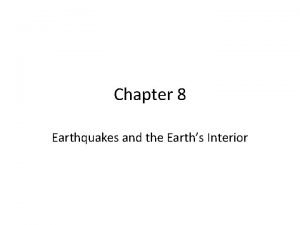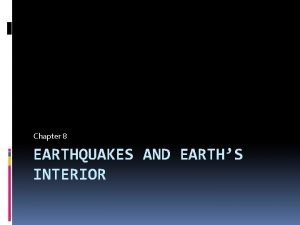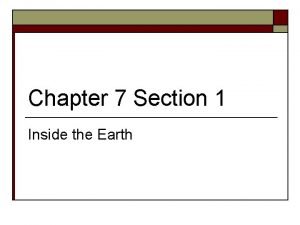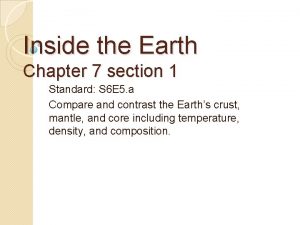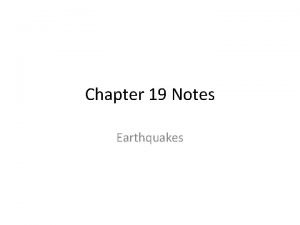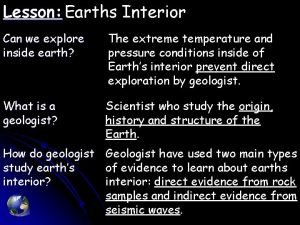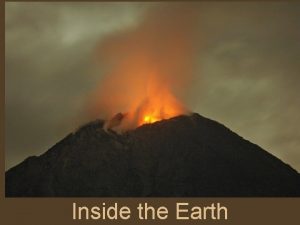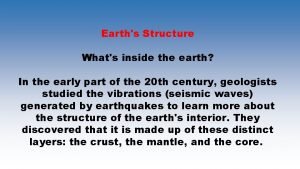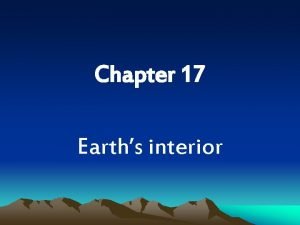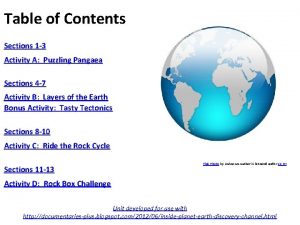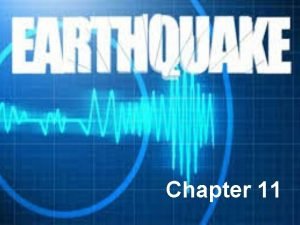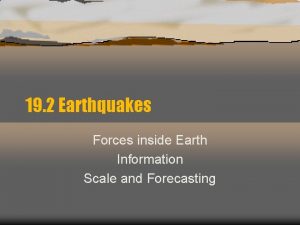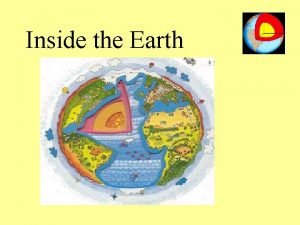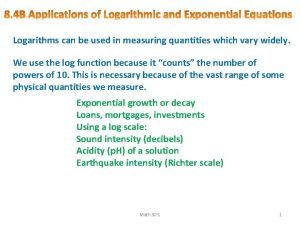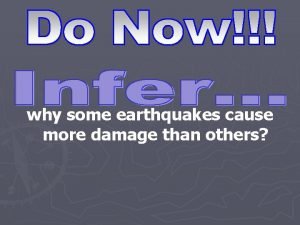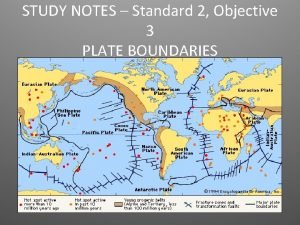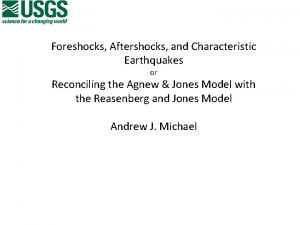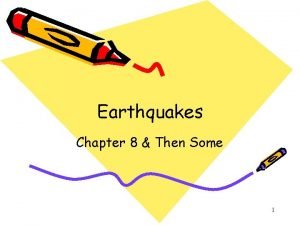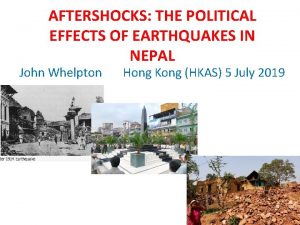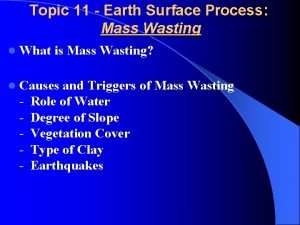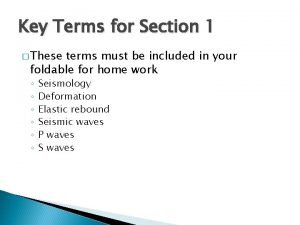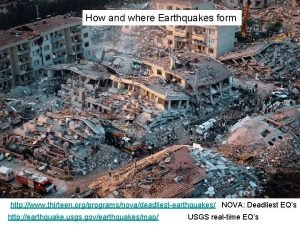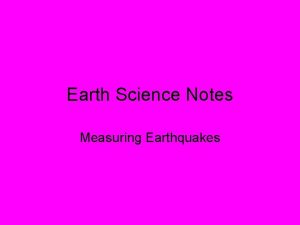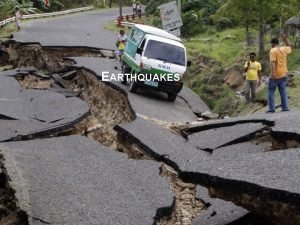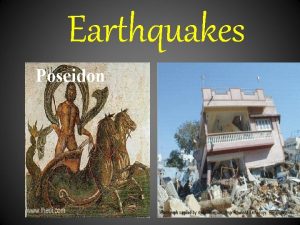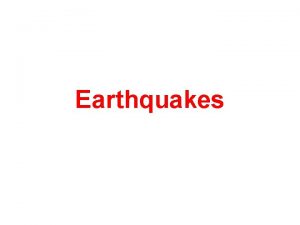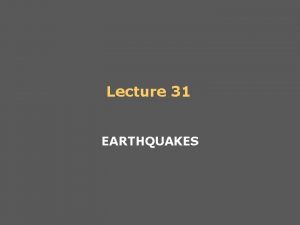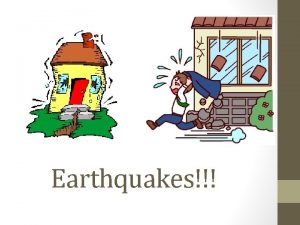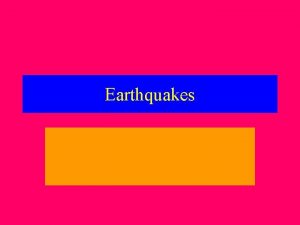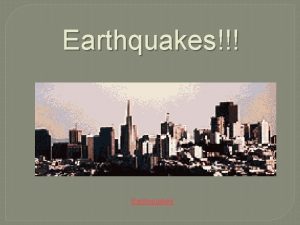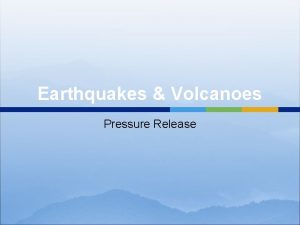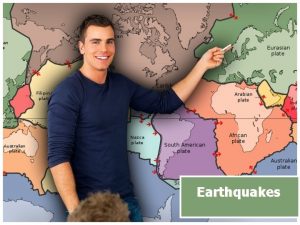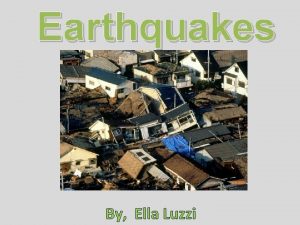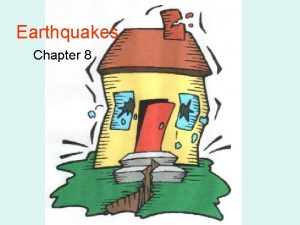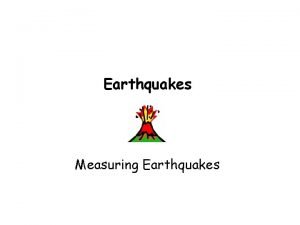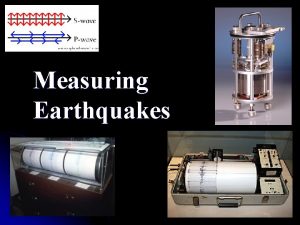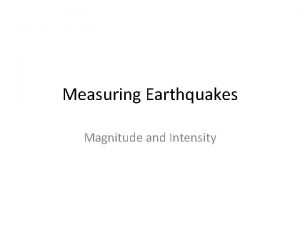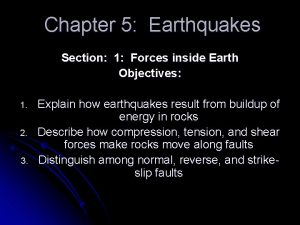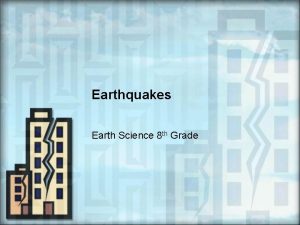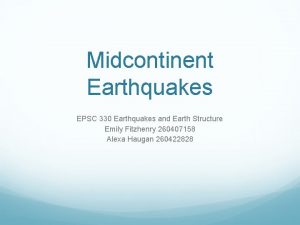Measuring Earthquakes Inside Earth Chapter 2 2 Pages
































- Slides: 32

Measuring Earthquakes Inside Earth Chapter 2. 2 Pages 64 -70

Fault • A break in Earth’s lithosphere (crust) where plates slide or move past each other.

Focus • Focus: Focus the starting point of an earthquake, usually underground • Depth of the focus is related to the type of boundary. – Transform: Shallow <300 m – Divergent: 300 m – Subduction: Deep 700 m

Epicenter • The point directly above the focus on the surface of the Earth is called the Epicenter

Seismic Waves • Vibrations caused by the energy of the earthquake that travel through the Earth’s interior and across the surface away from the focus Ø P-Waves Ø Surface Waves

Primary Waves • First Wave to Arrive – Squeeze and stretch rock, (Accordion-like) • Compression / tension stress – Passes through… • Solid rock • Magma • Ocean water • Air • Everything!

Secondary Waves • Arrive second, after P-waves – Vibrate from side to side, up and down – Shake the ground back and forth – Can not pass through liquids or gasses • Indicates that Earth has a liquid outer core.

Surface Waves • Travel along the Earth’s surface • Produced by P and S waves that reach the surface – Produce severe ground movement – Most damaging waves.

Seismograph • An instrument used to detect and record the seismic waves produced by earthquakes.

Seismograph • Consists of a heavy weight attached to a frame by a wire. • A pen is attached to a heavy weight. • The pen stays in place, the drum moves during an earthquake.

Seismogram • The record sheet the pen records on as the drum rotates.

Seismograph • More than 10, 000 Stations Use Data to… • Determine an epicenter – Need 3 Stations • Earthquake Magnitude

Locating an Epicenter • Need 3 Seismograph stations to determine their distance from the epicenter • Determine distance by: D = S-wave arrival time - P-wave arrival time.

Locating an Epicenter • Each station draws a circle. – Where all three intersect is the epicenter.

Magnitude • The measure of the amount of energy released in an earthquake – Three types • Mercalli • Richter Scale • Moment Magnitude.

Mercalli Scale • 12 steps describe how earthquakes effect people, buildings, and the surface • Rates earthquakes according to damage dealt to people and structures • Not a precise measurement.

Richter Scale • Developed in the 1930’s by Charles Richter • Rates the size of the seismic waves. • Measures the intensity of ground movements – Provides accurate measurements for small, nearby earthquakes, but does not work well for large or distant.

Richter Scale

Richter Scale

Moment Magnitude • Indicates the total energy released during earthquake’s more accurately • Scale used by scientists • Can be used for any size earthquake, near or far.

Moment Magnitude • Combines the following to determine the moment magnitude: 1. The type of seismic waves produced and their strength 2. How much movement occurred on the fault 3. Strength of the rocks that broke • 5. 0 Little damage • Above 5. 0 major damage

Moment Magnitude

The point under the surface directly where the Earthquake originates is… A. Fault B. Seismic Waves C. Earth’s Crust D. Focus E. Epicenter

The point on the surface above where the Earthquake originates. A. Fault B. Seismic Waves C. Earth’s Crust D. Focus E. Epicenter

The wave that arrives first is the… A. Secondary Wave B. Seismic Waves C. Sound Wave D. Primary Wave E. Tsunami Wave

The scale that measures the total energy released is the… A. Richter Scale B. Mecallie Scale C. Bathroom Scale D. Moment Magnitude E. Magnitude

How many seismograph stations are needed to locate an earthquake? A. 5 B. 3 C. 1 D. 6 E. 4

What to Work On • Read textbook pages 64 -69 • Answer the Section Review questions on page 69 (#’s 1 -4) DUE: Friday, October 21 st

Locating an Epicenter Lab • Purpose: Geologists who study earthquakes are called seismologists. If you were a seismologist, you would receive data from all across the country. Within minutes after an earthquake, seismographs located in Denver, Houston, and Miami would record the times of arrival of the P waves and S waves. You would use this data to zero in on the exact location of the earthquake’s epicenter.

Locating an Epicenter Lab • Seismograph Data: City Denver, CO Difference in P & S 2 min 10 sec Wave Arrival Times Houston, TX Miami, FL 4 min 5 min 40 sec

Locating an Epicenter Lab

Locating an Epicenter Lab 200 400 600 800 1000 1200 1400 1600 1800 2000 2200 2400 2600 2800 3000 3200 3400 3600 3800 4000 4200 4400 4600 4800 5000 (km)
 Chapter 8 earthquakes and earth's interior
Chapter 8 earthquakes and earth's interior Chapter 8 earthquakes and earth's interior
Chapter 8 earthquakes and earth's interior Printed pages vs web pages
Printed pages vs web pages In what section of earth do earthquakes happen?
In what section of earth do earthquakes happen? A large crack in the earth formed by a river or earthquakes
A large crack in the earth formed by a river or earthquakes Eamhttps://inside.amazon.com/pages/default.aspx
Eamhttps://inside.amazon.com/pages/default.aspx Chapter 7 section 1 inside the earth answer key
Chapter 7 section 1 inside the earth answer key Three compositional layers of the earth
Three compositional layers of the earth Chapter 7 section 1 inside the earth answer key
Chapter 7 section 1 inside the earth answer key Chapter 8 section 2 earthquake measurement answer key
Chapter 8 section 2 earthquake measurement answer key Chapter 8 earthquakes and volcanoes
Chapter 8 earthquakes and volcanoes Chapter 19 earthquakes
Chapter 19 earthquakes Chapter 19 earthquakes
Chapter 19 earthquakes Why is the inside of the earth hot
Why is the inside of the earth hot A dense ball of solid metal.
A dense ball of solid metal. Whats inside the earth
Whats inside the earth Produced from the heat inside the earth
Produced from the heat inside the earth Tasty tectonics answer key
Tasty tectonics answer key Forces inside earth
Forces inside earth Forces inside earth
Forces inside earth The layers of the earth from innermost to outermost
The layers of the earth from innermost to outermost Btn earthquakes
Btn earthquakes Explain natural disasters
Explain natural disasters Http://earthquake.usgs.gov/earthquakes/map/
Http://earthquake.usgs.gov/earthquakes/map/ Why do some earthquakes cause more damage than others
Why do some earthquakes cause more damage than others Frequent earthquakes in an area may indicate *
Frequent earthquakes in an area may indicate * Earthquakes
Earthquakes Quiz 1: earthquakes
Quiz 1: earthquakes Earthquakes
Earthquakes Mass wasting processes
Mass wasting processes Plastic deformation earthquakes
Plastic deformation earthquakes Why do earthquakes occur
Why do earthquakes occur Two types of body waves
Two types of body waves
